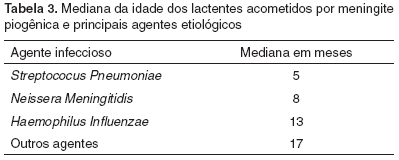PURPOSE: To analyze the prevalence of hearing impairment and to characterize the main auditory and neurological sequelae after meningitis, correlating the type of antibiotic used during the hospitali66zation period and the frequency of deafness, as well as the most prevalent type of meningitis as cause of hearing impairment. METHODS: Two hundred and eighty nine caregivers of children who were diagnosed with pyogenic meningitis between 28 days and 24 months, and had been admitted at Hospital Couto Maia (HC Maia) between January 2002 and December 2003 were contacted. The sample was composed of 55 children that survived with or without evident sequelae, who attended audiological and neurological evaluation. A complete audiological evaluation was carried out, including a subjective and objective battery of evaluation tests, using standardized instruments for investigation of children's hearing. RESULTS: The age range of the subjects when the audiological evaluation was carried out varied from two to five years. Hearing impairment was detected in 29% of the sample, characterizing, mostly, a profound bilateral neurosensory hearing loss. The main neurological sequelae found were: epilepsy, hemiparesy, hydrocephaly, dysphasia, and hyperactivity. CONCLUSION: The results indicate the need for audiological monitoring and neurological follow-up in children with previous history of pyogenic meningitis, especially those infected in early ages, seeking to identify possible hearing impairments and to intervene as soon as possible, through specialized intervention, prothetization, and oral language rehabilitation.
Meningitis; Deafness; Communication; Prognostic; Children




